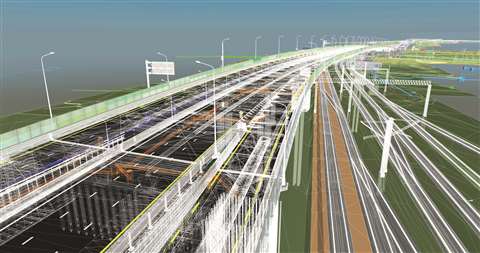The truth about BIM software
18 March 2022
Construction Europe talks to Fabio Ponzio of Hexagon Geosystems about why using building information modelling really can be good for business.
Digital technology has played a role in construction for many years, with – if the truth be told – little demonstrable advance in the industry’s levels of productivity.
A central element of this technology is BIM (building information modelling), which has been championed by many industry specialists as a ‘game changer’, due to its ability to help detect problems in the virtual world, before they become potentially expensive, dangerous and time-consuming in the real world.
 A BIM model view of transport infrastructure (Photo: Adobe Stock)
A BIM model view of transport infrastructure (Photo: Adobe Stock)
The question is, has BIM lived up to its early promise, or does digital technology such as this have a long way to go before it can genuinely make a difference to an industry that is crying out for change?
Construction Europe recently caught up with Fabio Ponzio, VP of building solutions at Hexagon Geosystems to get his views on one of the most talked about technologies in construction for the past 20 years.
Could you explain how BIM can improve productivity and efficiency through the entire lifecycle of a construction project?
Starting with the design and planning phase, BIM enables us to move more from a sequential process to a collaborative process between architects, engineers and other stakeholders.
BIM is more a holistic approach to handling information and defining geometry, material and more in a single model.
Design iterations and changes can be done quickly looking at a variety of factors like material cost, usability, energy, efficiency of construction, etc.
For construction planning, preparation and execution, the high level of details and information available from BIM makes construction more productive, efficient and helps to stay on budget and on time.
BIM is also improving operations as all the information related to building can be handed over to the owner. So, the owner knows exactly what has been installed and what material, pipes, etc, have been used and have easy access to manufacturing information as well.
At Hexagon, we have various solutions supporting the whole lifecycle of BIM.
Whether it’s capturing an empty site or an as-built environment of an existing building, BIM can and should be used throughout the entire lifecycle from design, construction to operations. It enables teams to become more efficient and sustainable from the project’s start to finish.
For example, Scan-to-BIM, the process of digitally capturing an existing building or construction site with 3D laser scanning technology, can be used to create a BIM model of an existing building.
Scan-to-BIM contributes to time and cost savings by increasing the speed of accurate data collection. It also positively affects workers’ safety by allowing them to remain at a distance while digitally capturing complex areas and environments.
Deploying 3D laser scanning solutions and software also leads to less rework, as inaccuracies are avoided at the initial planning stage instead of being incorporated into the project itself – which will cause problems later on.
Having a visual model or digital twin also means that everyone involved in the project can understand and explore the site without making visits – resulting in a decrease in machine use and harmful CO2 emissions and also in the number of face-to-face interactions as we continue to emerge from the pandemic.
 Fabio Ponzio, Hexagon Geosystems (Photo: Hexagon Geosystems)
Fabio Ponzio, Hexagon Geosystems (Photo: Hexagon Geosystems)
The collaborative BIM process also allows everyone on the team to work from the same detailed and accurate information source, making problems easier to identify and faster to resolve.
As the construction industry continues on the path of recovery and emerges from the global pandemic, digital solutions that connect sites and teams easily and quickly will be key, including adopting BIM throughout the construction process.
From design software to connected tools and visualisation within a BIM model, a dynamic flow of data between field and office will allow the digital world to better represent and interact with our physical reality.
Using the right digital solutions to transfer the design data from the office to the field accurately and in real-time reduces rework, waste and delays on construction sites.
Office-to-Field integration with software and sensor solutions reduces the efforts for point layout creation in the office. It boosts productivity and quality in the field with a constant feedback loop.
For example, the construction-centric BIM-to-Field workflows supported by Leica’s iCON solutions ensure connectivity with all leading CAD and BIM software and all industry-standard file format.
The iCON build portfolio seamlessly embeds into BIM workflows allowing customers to participate in projects mandated to use BIM processes, leading to increased opportunities for more business and more efficient BIM-to-Field workflows.
Do you think BIM is currently seen as a contract-winning tool for large contractors, or is it now better understood and being used to greater purpose within both the tier one and SME community?
BIM adoption varies regionally. Some countries are further ahead as BIM, where has been mandated by the government. Still, many architects, engineers and contractors are using more traditional CAD methodology as well.
Many companies are using CAD and BIM depending on the project. We see smaller and bigger companies adopting BIM and investing in tools like reality capture for Scan-to-BIM workflows.
For example, in Spain, Sertogal SL used the Leica Geosystems’ reality capture solutions to create a BIM model that guided the remodelling and expansion of the electrical substation of Mera in the province of Ourense – part of an ambitious initiative to partly absorb the energy production generated by 17 new wind farms planned in the region.
In the Netherlands, engineering firm BIM4ALL, a member of the Brevo Group, was commissioned to document sewer pits across the whole country – around 10% of 80 million of these were in need of replacement due to corrosion from hydrogen sulfide gas.
To achieve this, BIM4ALL deployed the Leica RTC360 3D laser scanner to document 5m-deep pits – capturing 2 million points per second; each pit only took 15 to 30 minutes to complete. Based on this scanning data, BIM4ALL can create accurate BIM models of existing conditions as well.
Fabio Ponzio is vice president of Building Solutions at Hexagon’s Geosystems division, a provider of information technologies that capture, measure and virtualise construction project data. The company’s reality-capture technologies - digitising anything from the walls of a house to an entire city - provide construction professionals with actionable information for planning and project execution.
For more information, visit www.hexagon.com
MAGAZINE
NEWSLETTER
CONNECT WITH THE TEAM







